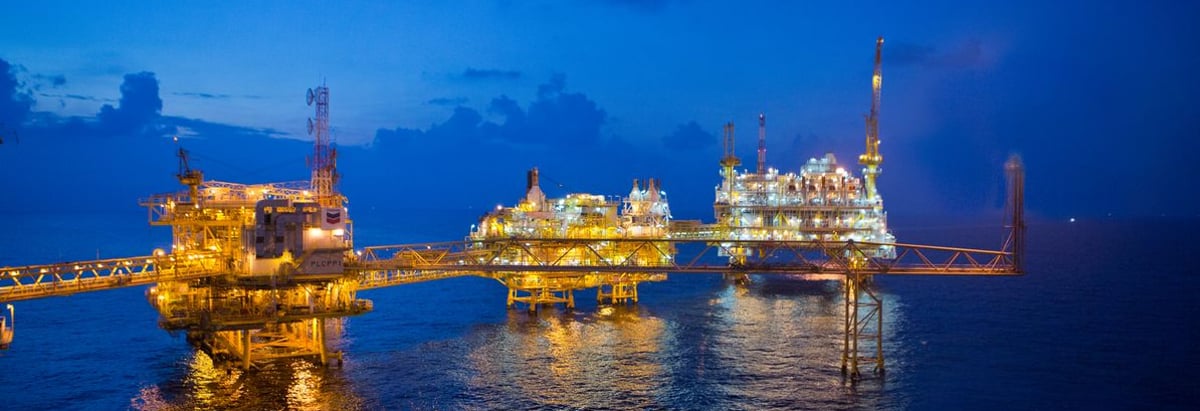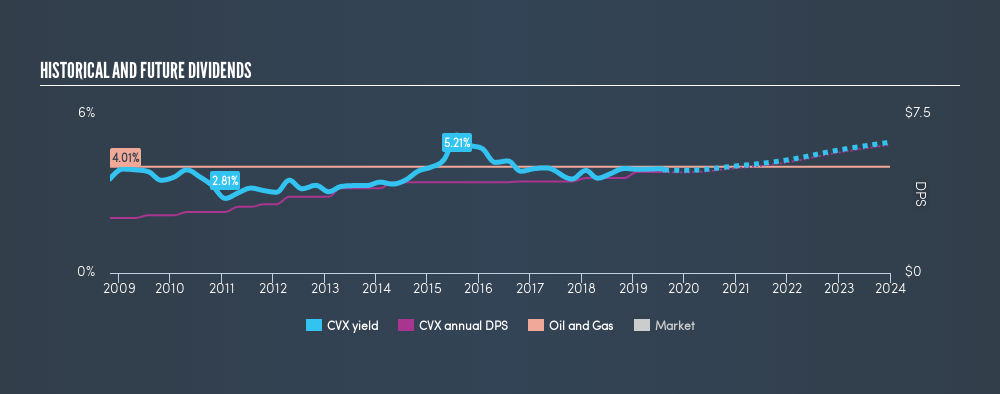
Readers hoping to buy Chevron Corporation (NYSE:CVX) for its dividend will need to make their move shortly, as the stock is about to trade ex-dividend. You will need to purchase shares before the 16th of August to receive the dividend, which will be paid on the 10th of September.
Chevron's next dividend payment will be US$1.19 per share. Last year, in total, the company distributed US$4.76 to shareholders. Based on the last year's worth of payments, Chevron stock has a trailing yield of around 3.9% on the current share price of $122.42. Dividends are a major contributor to investment returns for long term holders, but only if the dividend continues to be paid. So we need to investigate whether Chevron can afford its dividend, and if the dividend could grow.
View our latest analysis for Chevron
If a company pays out more in dividends than it earned, then the dividend might become unsustainable - hardly an ideal situation. Chevron paid out 59% of its earnings to investors last year, a normal payout level for most businesses. Yet cash flows are even more important than profits for assessing a dividend, so we need to see if the company generated enough cash to pay its distribution. It distributed 47% of its free cash flow as dividends, a comfortable payout level for most companies.
It's positive to see that Chevron's dividend is covered by both profits and cash flow, since this is generally a sign that the dividend is sustainable, and a lower payout ratio usually suggests a greater margin of safety before the dividend gets cut.
Click here to see the company's payout ratio, plus analyst estimates of its future dividends.

Have Earnings And Dividends Been Growing?
Companies with falling earnings are riskier for dividend shareholders. If earnings decline and the company is forced to cut its dividend, investors could watch the value of their investment go up in smoke. Readers will understand then, why we're concerned to see Chevron's earnings per share have dropped 7.0% a year over the past five years. Such a sharp decline casts doubt on the future sustainability of the dividend.
Another key way to measure a company's dividend prospects is by measuring its historical rate of dividend growth. Chevron has delivered 6.2% dividend growth per year on average over the past 10 years. That's interesting, but the combination of a growing dividend despite declining earnings can typically only be achieved by paying out more of the company's profits. This can be valuable for shareholders, but it can't go on forever.
To Sum It Up
Should investors buy Chevron for the upcoming dividend? The payout ratios are within a reasonable range, implying the dividend may be sustainable. Declining earnings are a serious concern, however, and could pose a threat to the dividend in future. It might be worth researching if the company is reinvesting in growth projects that could grow earnings and dividends in the future, but for now we're not all that optimistic on its dividend prospects.
Ever wonder what the future holds for Chevron? See what the 13 analysts we track are forecasting, with this visualisation of its historical and future estimated earnings and cash flow
We wouldn't recommend just buying the first dividend stock you see, though. Here's a list of interesting dividend stocks with a greater than 2% yield and an upcoming dividend.
We aim to bring you long-term focused research analysis driven by fundamental data. Note that our analysis may not factor in the latest price-sensitive company announcements or qualitative material.
If you spot an error that warrants correction, please contact the editor at editorial-team@simplywallst.com. This article by Simply Wall St is general in nature. It does not constitute a recommendation to buy or sell any stock, and does not take account of your objectives, or your financial situation. Simply Wall St has no position in the stocks mentioned. Thank you for reading.
About NYSE:CVX
Chevron
Through its subsidiaries, engages in the integrated energy and chemicals operations in the United States and internationally.
Excellent balance sheet established dividend payer.
Similar Companies
Market Insights
Community Narratives



